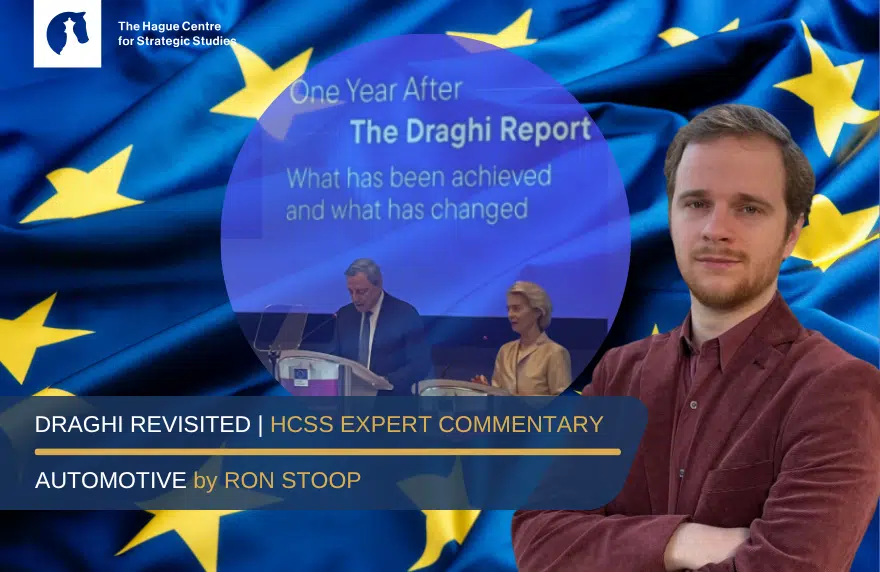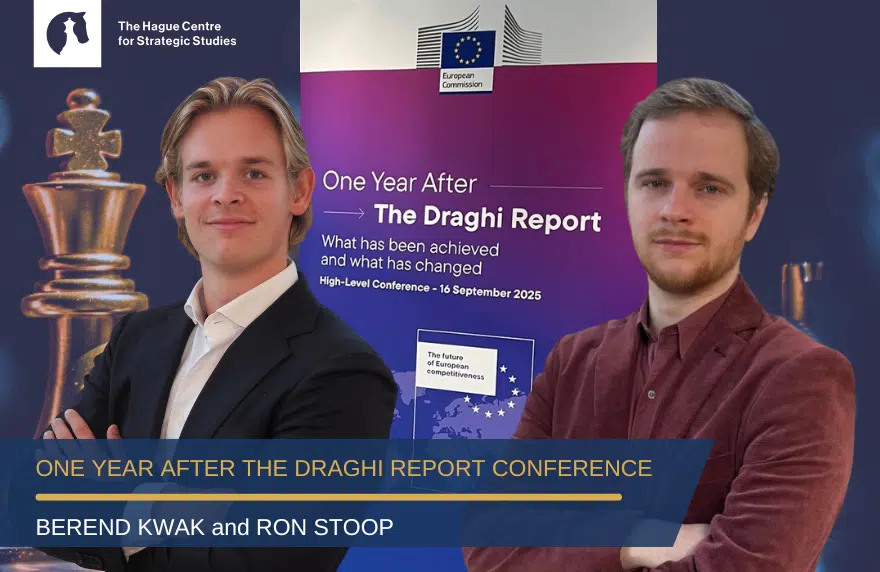One year after Mario Draghi’s landmark report, how far has Europe come in securing its automotive future? In the first article of our Draghi Revisited Series, HCSS analyst Ron Stoop examines the EU’s progress in the automotive sector. From EV tariffs and Chinese competition to emission targets and charging infrastructure, what steps have been taken—and where do the biggest gaps remain? Read his sharp analysis on Europe’s industrial resilience.
On September 16, HCSS analysts Ron Stoop and Berend Kwak joined the European Commission’s High-Level Conference “One Year After the Draghi Report: What has been achieved and what has changed”, in Brussels.
Featuring keynote speeches from EU Commission President Ursula von der Leyen and Mario Draghi himself, alongside leading voices from academia, thinktanks, business, and European institutions, the event was a poignant reflection on a turbulent year for Europe.
Since last year, tensions with both China and the US have escalated. Europe’s trade model is coming under severe pressure. Defence, raw materials, cleantech and digital sovereignty are still far away. Some areas have seen small steps, but most of them are still far from where they should be. The EU must act, or it will perish as a meaningful geopolitical entity. The upcoming years will be Europe’s geopolitical college years. But graduation is not guaranteed by any means.
Ron and Berend were invited due to their publication of the HCSS Draghi Report Series last year, which explored the long-term implications of Draghi’s recommendations. Now, one year later, it’s time to sit down again with our expects for a second time, to see what Europe has done with the report’s stark warning to clean up its economic and industrial act.
For the first article in our Draghi Revisited Series, strategic analyst Ron Stoop gives his take on the Automotive sector.
Since the publication of the Draghi Report, what concrete steps have been taken at the EU and member state level in the Automotive sector, and how effective have they been so far?
Ron Stoop: When the Draghi Report was released last year, the EU was in the middle of the EV ‘tariff war’ with China. The EV tariffs, ranging from 27% to 45%, were just introduced a few months earlier, and several Chinese EV companies were prospecting for possible production sites in the EU to circumvent the tariffs. However, after 26 October, when the Chinese government strongly advised Chinese EV companies not to invest in countries that voted in favour of the EV tariffs, many prospecting operations ended. A few Chinese investments have come through in Europe, but less than in other regions such as in Southeast Asia and the MENA region.
For the domestic carmakers, the picture is mixed. Overall, EVs are still gaining ground in Europe, with a sales percentage of 15% (a 3% increase compared to the year before). Companies like Volkswagen and BMW are leading the charge on EV sales within Europe. Other companies, like Mercedes, have not managed to successfully shift to EVs.
Where do the biggest gaps lie between political ambition and practical implementation, and why do they exist?
Ron Stoop: The EU wanted to stop the massive influx of Chinese cars on the internal market. However, when the tariffs on Chinese EVs were introduced, Plug-in Hybrid Vehicles (PHEVs) were not included. As a result, PHEV imports from China to the EU increased significantly. This not only led to increased penetration of Chinese vehicles on the European market, but also to some displacement of the sale of ‘pure’ electric vehicles.
Another worrying development is the lobbying of car manufacturers to weaken the emission goals that the EU has set for EU carmakers, which can result in fines if emission limits are exceeded. The emission goals provide a clear incentive for carmakers to decisively shift to electric vehicle production. Likewise, the push to revert the 2035 ban on the sale of cars that run on fossil fuels could seriously weaken the focus of European car companies towards electric mobility.
Looking ahead, what should be the EU’s top two or three priorities to stay competitive, and where might it make sense to scale back?
Ron Stoop: Firstly, the EU should stay firm on emission targets and the 2035 ban on the sale of internal combustion engine cars. These pieces of legislation have been key in pivoting the EU market towards EVs.
Secondly the EU and its member states should support deployment of charging infrastructure across the whole continent. Impressive gains have been made, but there is still uneven coverage across EU-member states. Plugging these gaps will be essential to support further EV adoption.
Finally, the EU should prioritise business fleet decarbonisation. Companies that lease large amounts of cars have been leading the EV transition in several countries. Within that prioritisation, it would be wise to include ‘buy European’ clauses, to make sure these investments will also generate European jobs and know-how. Likewise, when grants and subsidies related to electric mobility are given, ‘buy European’ clauses should be included.
If we meet again in a year, what single measurable outcome would convince you that Europe is on the right track in this sector?
Ron Stoop: I would look at the EV sales numbers of the European carmakers to see if they have decisively pivoted away from ICE cars and whether they have proven they can compete in foreign markets.







